Valiant Project Leader Robert N. Sinclair on the 1960 Chrysler Valiant
We have seen how Valiant was conceived . . . how the design objectives were established . . . and briefly, what had to be done to meet these objectives. We have also acquired an insight into Valiant styling. Finally, let us take a look at some of the interesting engineering features of this new automobile.
Once the design goals had been established, a special task force was created at Chrysler Corporation to concentrate solely on this product. This work group was composed of selected engineers, stylists, designers, and manufacturing specialist with just one objective: the design, development, and production of the Valiant.
By using this approach it was possible to conduct a highly accelerated and totally coordinated design and development program maintaining an extremely high level of discipline in all decision-making areas. This method of operation was employed at the outset of product concept studies conducted in support of the Corporate Special Car Committee investigation that commenced early in 1957. It was maintained throughout the entire program, and is clearly justified when considering that final production design started in July, 1958, and that the first Valiant rolled off the assembly line in September, 1959.
 Basic engineering objectives were clear. Most efficient use of space within the skin of the car was to be achieved wherever this was economically feasible. Valiant was to incorporate the most advanced design techniques; however, while innovation was strongly desired, radical approaches would not be taken for the sake of novelty alone. The car had to offer outstanding value for its initial price, and therefore economies had to be achieved in design. Parts were to be combined and weight savings achieved wherever possible. But the car was not to be overly austere in interior or exterior appearance, or in function, just for the sake of economy. Lively acceleration performance, in combination with excellent fuel economy, required maximum design efficiency -- in total, and in every component.
Basic engineering objectives were clear. Most efficient use of space within the skin of the car was to be achieved wherever this was economically feasible. Valiant was to incorporate the most advanced design techniques; however, while innovation was strongly desired, radical approaches would not be taken for the sake of novelty alone. The car had to offer outstanding value for its initial price, and therefore economies had to be achieved in design. Parts were to be combined and weight savings achieved wherever possible. But the car was not to be overly austere in interior or exterior appearance, or in function, just for the sake of economy. Lively acceleration performance, in combination with excellent fuel economy, required maximum design efficiency -- in total, and in every component.
Basic Layout
Valiant was designed from the inside out. It was designed around a family of six -- their comfort, their convenience, and their needs. Figure 1 indicates how the passenger and luggage compartments were maximized in the over-all layout of the car, and how invasion of those areas by the powerplant, drive train, fuel tank, and spare tire have been minimized.
To minimize toe board intrusion, the 170-cubic inch, line-six engine is located well forward in the car. Fan to grille surface dimensions are unusually small. The engine is inclined 30° to the right for a number of reasons, prime-most being to offset the water pump alongside the block to reduce engine length. The use of compact transmissions and a high-offset axle . . . all designed expressly for Valiant . . . results in a modest tunnel. And the nesting of the 13-gallon fuel tank and spare tire well below the rear deck floor allows maximum luggage capacity.
In passenger compartment layout, traditional ground rules for the interior dimensions of standard domestic cars were faithfully observed. This can be seen in the following tabulation:
| Leg room, front: 44.4" Leg room, rear: 38.9 Leg room, brake pedal: 37.4 Rear knee room: 28.0 Loaded head room, front: 37.9 Loaded head room, rear: 37.4 |
Seat height, front: 11.4 Seat height, rear: 14.0 Brake pedal to steering wheel: 24.4 Steering wheel to seat back: 15.1 Steering wheel to seat cushion: 6.2 |
Only in width are noted major differences between Valiant and larger American cars. And although the Valiant body is only 67" across "B" pillars, average front and rear hip room is only 1.4" less than a 1954 Plymouth, which was a full 5" wider across "B" pillars.
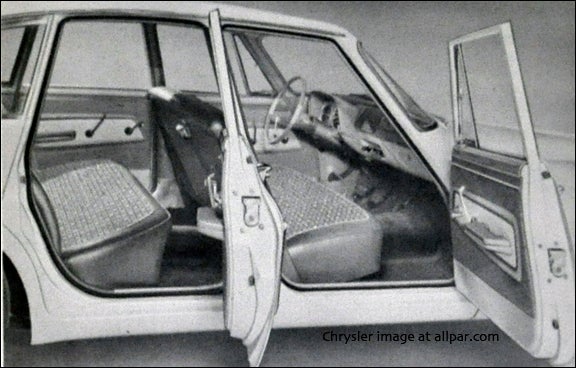
Figure 2 further illustrates the Valiant space use story. The thin doors with their rolled section upper frames and flush side windows promote full use of the car's width. The generous 70° openings of the in-swinging-hinged doors, and the high roof rails allow outstanding ease of entry and exit. Straightline "A" pillar design and more than ample steering wheel to front cushion clearance contribute to front compartment accessibility. It may be seen that front and rear knee room have been carefully attended to in instrument panel and front seat back design. The instrument panel surface drops rapidly from the base of the windshield and sweeps forward and down below the peak line, providing excellent front passenger knee clearance. A trim wire is used to recess the front seat back, providing an additional 0.8" rear knee room that would not otherwise exist. The low floors, front and rear, are allowed by "Unibody" construction and provide very satisfactory seat heights.
In the luggage compartment, 24.9 cubic feet of usable space are provided by the manner in which the spare tire is stored below the floor, with the fuel tank nested ahead of the well and behind the axle. The tire well has a cover which is concealed under a fitted floor mat. Luggage access is excellent because semi-fast back styling allowed a low deck opening sill, elimination of the deck upper panel, and a deck lid hanging virtually from the package shelf.
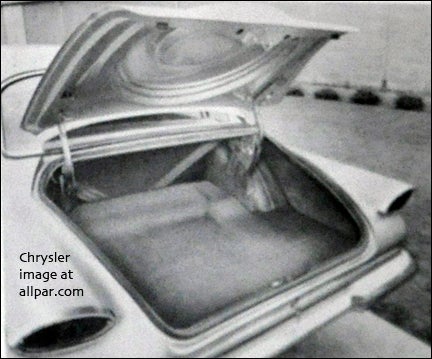 | 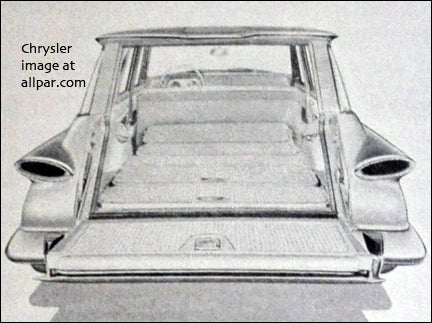 |
Both two and three-seat Valiant Suburban models, shown in Figure 4 with seats folded, offer a cargo-carrying capacity of over 72 cubic feet. An uninterrupted cargo deck extends over 82" from the tail gate to the front seat back. The rear opening is of generous dimensions and the tail gate, with its retracting glass, is designed to support heavy cargo loads in the down position.
In addition to being efficient in the use of space, Valiant was to feature driver control. As can be seen in Figure 5, the instrument panel and controls are driver-tailored. Dials, switches, and warning lights are clustered immediately below the driver's forward line-of-sight; heater and transmission push buttons are symmetrically placed in vertical banks flanking the instrument cluster, where they offer rapid finger-tip control; the parking sprag and heater water valve controls take the form of convenient slide-type levers located below the respective push buttons. The short-throw manual transmission gear-shift is conveniently placed at the driver's right hand for effortless, positive shifting; parking brakes feature the advantage of step-on pedal operation and hand release.
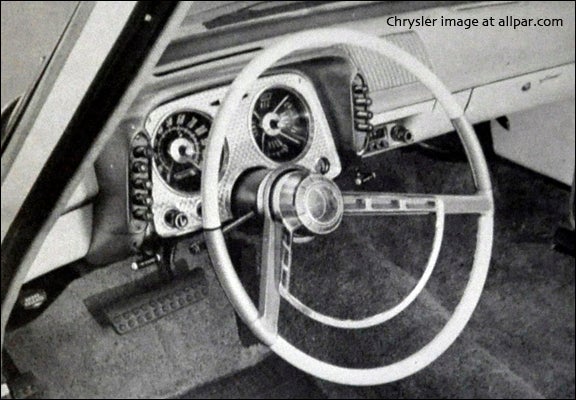
Body Construction
Valiant's full unit body construction was the most efficient way of achieving maximum usable space. It was the only feasible way to meet strength, weight, and durability objectives.
The Valiant body is a further step in a program of unit-construction development that has extended over many years at Chrysler Corporation. The Valiant structure is based on Unibody designs, with one major difference. Instead of a bolted-in fore-structure, Valiant incorporates welded-in front understructure and stressed front sheet metal.
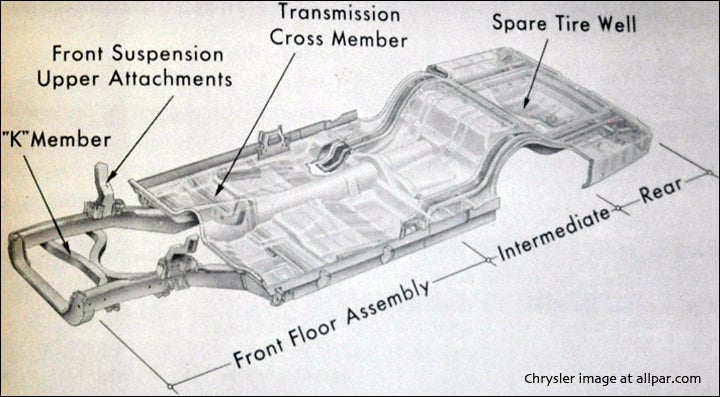
The Valiant body consists of a welded and reinforced shell of high bending and torsional stiffness, in which the "monocoque" principle is employed to the fullest extent possible. Every component has an important strength function . . . fenders, quarter panels, floor, and roof all contribute to the over-all stiffness of the body. The plenum chamber boxes in the cowl. The fender side shields perform a vital front end function. A unit wheelbase torsional rigidity of 85,000 lb/ft/degree/ft has been achieved. A unit wheelbase comparison shows the Valiant car to be 95% stiffer in torsion and 50% stiffer in beam than a 1959 Plymouth with separate body and frame construction. Dynamic testing has shown that high structural resonant frequencies have been attained, indicating greater damping and, therefore, reduced body shake.
The ladder-type underbody incorporates rugged box-section members. Front longitudinal, rear longitudinal, and body side sills are interconnected by five cross members. This structure is unique in that the same stampings and floor pan subassemblies are used for both sedan and suburban models. The tire well in the rear pan doubles as a foot well for three-seat suburban models.
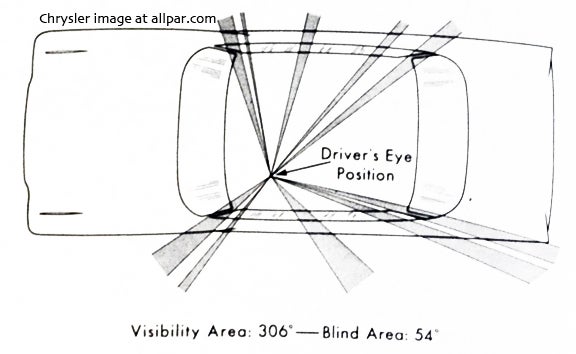
The upper structure features six pillars . . . narrow straight "A" pillars, tailored "B" pillars and thin "C" pillars . . . with separately-framed rear quarter windows. All door pillars, roof rails, headers and beltline rails are boxed. Superstructure weight has been minimized by the optimum use of light gauges, sculpture sheet metal, and minimal section sizes, but outstanding rollover protection has been retained. The "greenhouse" affords 306° of unobstructed visibility at driver eye-level.
The all-welded structure ahead of the cowl, in addition to performing its expected structural functions, is expressly designed to facilitate final line car assembly. The front rails are spaced to receive the engine from beneath in the body drop operation. The fender shields, deep-section shear panels, are welded to the front rails, to the dash, and to the radiator yoke, forming an assembly of great torsional rigidity. The radiator yoke acts as a forward bulkhead, resisting shear induced under nonsymmetrical loading. Front rail sections were determined by consideration of beam strength required and loads induced in the suspension attachments. Upper control arm and shock absorber loads are distributed into the body through the shock towers, rails, fender side shields, and cowl structure. Front suspension torsion bar loads are received by the anchors in the transmission support cross member, beneath the front floor. The front fenders, though bolted-on for service and assembly adjustment reasons, provide substantial beam support along the upper edges of the shear panels.
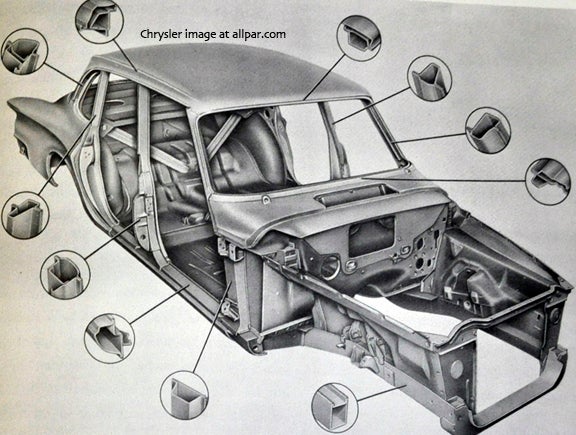
The rear structure is composed essentially of the quarter panels, rear window and deck lid opening reinforcements, a lower structural panel and diagonal cross braces behind the rear seat. Rear longitudinals are designed to withstand luggage and suspension beaming, and to sustain rear impact loads. Torque boxes between the rear longitudinals and the sill maintain over-all beaming continuity, and receive rear suspension, driving, and braking forces through the rear spring front hangers.
Numerous unique design details are incorporated in the design of the Valiant body.
Among these is a combination wind cord/weatherstrip. The weatherstrip is a single, extruded tubular section of cellular sponge rubber and is supported by a flexible steel core covered with polypropylene lace which forms the wind cord. This is attached to the door opening flanges by means of spring clips located at intervals within the core strip.
The deck lid opening extends to the base of the back light, eliminating a separate upper deck panel. This is allowed by the use of high hinges and torsion bar counter-balance springs in combination with a high rear shelf panel. Both hood and deck lid are reinforced with structural inner panels. A new oven-cured expandable sealer is used as a bond and sound deadener between the hood inner and outer panels.
Suburban body structure is the same as that of the sedan back to the "C" pillar, with the exception, of course, of the roof panel. Different upper quarters extend rearward to the tail gate opening, and full inner quarter panels are used. Auxiliary rear floor panels are used to elevate the rear floor to axle kick-up height and to receive the third seat when folded flat. A cargo floor extending to the back of the front seat is achieved by hinging the second seat back well forward and by the use of a second seat filler panel. The cargo area is designed for 50 pounds per square foot static load, 110 live. Tail gate structural requirements were equally stringent, specifying support of a 350-pound load at the extremity of the lowered tail gate.

Suburban tail gate hardware is of interest. The dual locks are operated by a torsion bar actuating handle at the center line of the gate. Counterbalancing is provided by a similar torsion bar arrangement located within the gate and extending to the right pillar.
Corrosion Protection
The corrosion protection treatment given to the Valiant body is exactly the same as that used on other 1960 Corporation cars, and is considered the most advanced in the industry. Basically, the treatment consists of a comprehensive six-stage immersion and spray sequence which cleans and coats the entire raw body, followed by the application of a new water-reducible primer to the critical lower body area. During the immersion and spray sequence, the body if first cleaned with an alkaline cleaner, rinsed, coated with phosphate, rinsed again, then dried and cooled to room temperature. Finally, the entire underbody is dipped in the newly-developed primer. This process is considered to be superior to those previously used, both in efficiency of application and in the durability of the primer. After the coated body is dried, the exterior is sprayed with two base coats of an epoxy paint followed, after wet sanding with two baked-on coats of Lustre-Bond enamel.
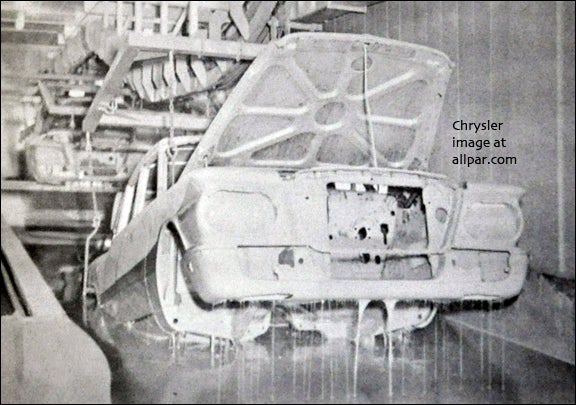
Soundproofing
The same soundproofing methods used on other Chrysler Corporation 1960 cars are used in the Valiant body. In this treatment, floor areas are sprayed with approximately 3/32 inch of fluid deadener, locally blanketed with 1/8 inch felt and mastic pads, and covered with preformed jute silencer pads, 3/4 inch front and 3/8 inch rear. The dash is insulated with a two-ply felt and one-inch thick fiber glass liner. Cowl sides use 3-ply felt and one-half to one inch of fiber glass. The roof is line with a matted fiber pad, and incorporates structurally-tuned roof bows. A total of 54 pounds of fluid deadener is sprayed on the insides of doors, quarter panels and wheelhouse areas. And if factory undercoating is specified another 33 pounds of fluid deadener is added, together with a fiber glass hood liner. Dash panel insulation is made as effective as possible by the use of a unique "keyhole" grommet, designed to concentrate all wiring and cables leading through the panel into a single, rubber-insulated assembly.
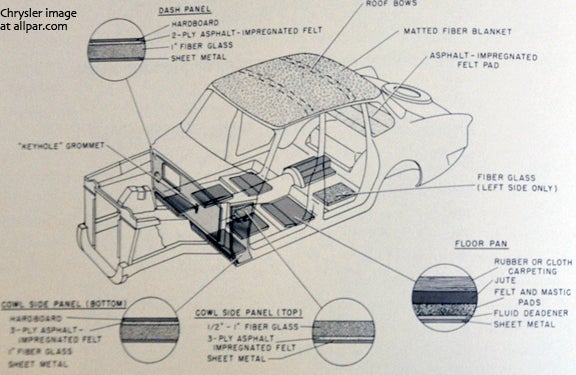
Chassis Layout
Figure 13 illustrates Valiant's over-all chassis layout, with its front engine location, conventional drive train, and Torsion-Aire suspension system. Most of the components shown here are carried on a pedestal conveyor into the body drop in final line car assembly, with the engine and much of the front suspension and steering linkage carried on the bolt-in engine support cross member.
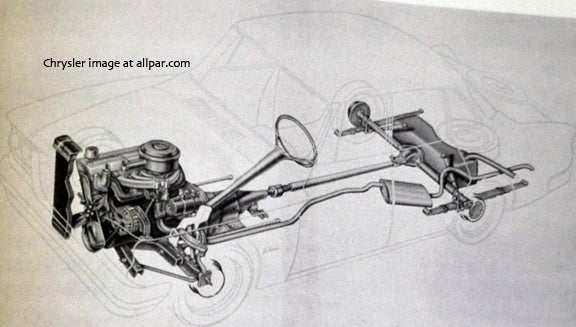
Engine
To achieve the car performance and fuel economy objectives specified for Valiant, an entirely new 170-cubic inch, water-cooled, in-line six-cylinder engine was designed. The Valiant engine had to be as compact as possible while possessing excellent durability and reliability in operation. It had to offer high specific output and fuel economy commensurate with the over-all concept of the vehicle.
Valiant's engine characteristics, dimensions, and configuration were determined early in total car studies. The 30° inclination was actually established well before such basics as bore centers and displacement potential were finalized for a number of sound reasons: 1) Over-all engine length and, therefore, front overhang and over-all car length could be significantly reduced by offsetting the water pump; 2) a highly efficient, long branch intake manifold could be adopted; 3) minimum side-view silhouette potential would be guaranteed; and 4), the center of gravity of the vehicle would be slightly lowered. Left and right inclinations were lowered. Left and right inclinations were studied. Inclination to the right was selected for reasons of engine compartment layout, drive line geometry, simplifications of controls, and engine serviceability.
Bore and stroke of 3.40 x 3.12 inches, wedge-type combustion chambers, and a compression ratio of 8.6:1 were selected to incorporate the advantages of contemporary design practice and for efficient operation on regular grade fuel. The cast-iron cylinder block was designed for maximum strength and durability, with complete circumferential cooling of the cylinder barrels. The lower flange of the block extends 7/8 inch below crankshaft centerline. The forged-steel crankshaft follows current Chrysler V8 design practice, with very large overlaps between connecting rod and main bearing journals. A torsional vibration damper is used to obtain maximum running smoothness.
The chrome alloy cast-iron cylinder head incorporates integral valve guides and seats. A notable feature of the valve train is the use of stamped steel rocker arms, arranged on a single rocker shaft, the whole assembly being clamped to seven pedestal supports cast integrally with the cylinder head. Tubular steel push rods with hardened tip inserts are used with solid mechanical tappets. Reaction to push rod angularity is provided by hardened, tubular steel rocker arm spacers. The whole valve gear is carefully designed to minimize float at engine speeds in excess of 5000 rpm. Four-bead locks on the exhaust valves allow free rotation for long life. The four-bearing camshaft is mounted high on the right side of the cylinder block.
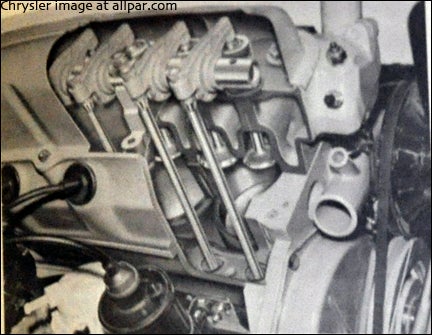
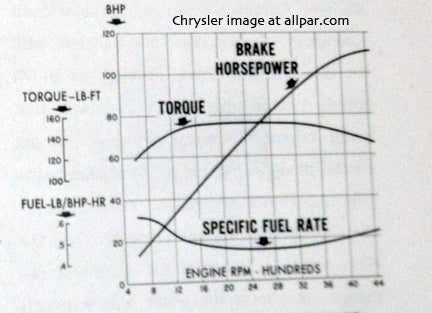 Full-pressure lubrication is employed, with a full-flow oil filter mounted on the oil pump body. The cooling system incorporates a semiseries flow path with a permanent bypass.
Full-pressure lubrication is employed, with a full-flow oil filter mounted on the oil pump body. The cooling system incorporates a semiseries flow path with a permanent bypass.
The Valiant engine possesses excellent breathing characteristics. Generous valve diameters, individual cylinder porting, and highly efficient intake and exhaust manifolds were all selected for uniform fuel distribution and highest volumetric efficiency consistent with sound practice. The aluminum intake manifold branches vary in length from 9.6 to 15.1 inches, and although too short to provide resonance supercharging at normal engine speeds, their effect on mixture distribution is revealed by the high, flat engine torque curve. In the early stages of design, a number of sets of more conventional rake-type manifolds were evaluated. On the average, they lowered engine output by 9%. The torque curve peaks at 151 pound-feet from 2400 to 2800 rpm -- 134 psi BMEP. This is excellent for an engine of this size. Furthermore, this level of performance is nearly constant from 1600 to 3200 rpm. Minimum BSFC of 0.45 lb/BHP-HR is also highly respectable for an engine of this displacement operating on regular grade fuel, and is indicative of the high thermal efficiency of the engine.
The fuel system utilizes a single-throat, downdraft carburetor, equipped with an automatic choke and unique torque-rod throttle linkage. A warm up stove beneath the carburetor is supplied through the thermostatic heat control valve in the exhaust manifold.
A newly-designed, Chrysler-built distributor, mounted on the right side of the engine, features a die-cast aluminum body and incorporates centrifugal and vacuum advance. Nylon is used for the breaker arm and rubbing block to improve performance and give longer life. Long reach spark plugs are housed in stamped steel wells and protected by one-piece rubber boots.
Alternator
Another Valiant feature is the heart of its 12-volt electrical system. Instead of a conventional DC generator, Valiant carries an all-new, Chrysler-designed, Chrysler-built alternator. This machine, with its die-cast aluminum housing, is 9-1/2 pounds lighter than the DC generator that would otherwise have been used. Its six silicon diodes, mounted in the housing, provide full-wave rectification. Advantages include simplified voltage regulation and the elimination of the need for a current regulator. But most important, this unit will provide a full 10 amperes at engine idle, improving battery life and charging condition when electrical demands are heavy.
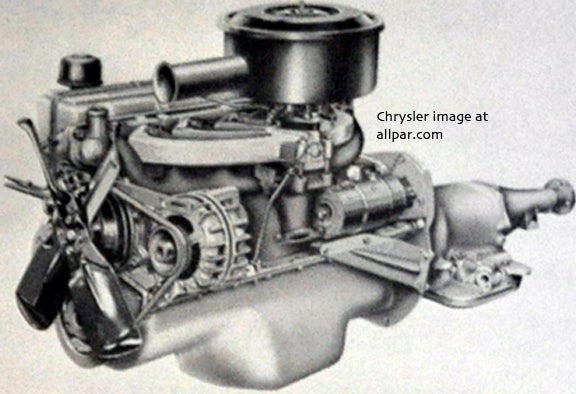
Engine Mountings
Introduction of an entirely new engine permitted complete freedom of engine mount design. The inclination of the new engine precluded the use of symmetrical designs of known characteristics. An extensive analysis of all vibration modes was therefore conducted to determine optimum theoretical mounting locations, rates, and configurations. Emphasis was placed on maximizing engine isolation with the attainment of very low powerplant suspension frequencies, so that the powerplant would serve as a dynamic absorber in body shake frequencies. Large volumes of rubber were used to achieve this effect . . . perhaps a greater amount per unit of powerplant weight than has previously been used in any American-built passenger car. The front mountings are of the vertical shear-type, consisting of a rubber sandwich boned to steel plates. The single rear mounting, located on the transmission extensions, consists of a single block of rubber bonded to steel plates which are in turn attached to a short drop-out cross member.
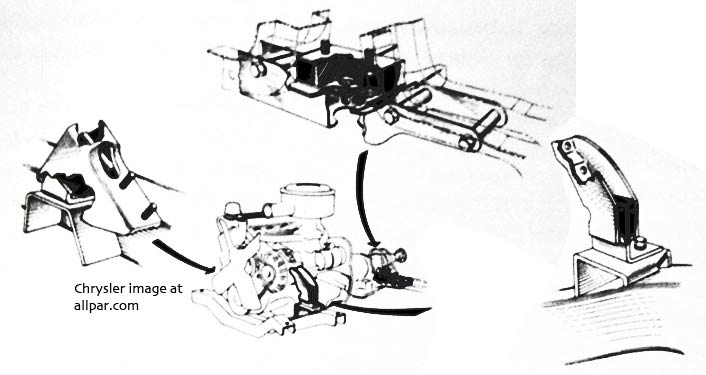
Transmission
Two new transmissions have been engineered for Valiant, a three-speed manual unit and a three-speed automatic.
The manual transmission is conventional, compact, and light. It is rotated 30°, opposite the inclination of the engine, to allow space for shift linkage within the relatively low, narrow tunnel. Consistent with American practice, second and third gears are synchronized. The first gear ratio is 2.7:1; in second gear 1.83:1, and reverse 3.49:1. The clutch is a single, dry plate type, operated by a suspended pedal linkage incorporating a pre-adjusted overcenter spring. A short, floor-mounted control lever is connected to the transmission through a linkage designed for positive, minimum-effort gear changing. A simple torque shaft arrangement is inserted in the second-direct linkage to isolate the control lever from engine movements.
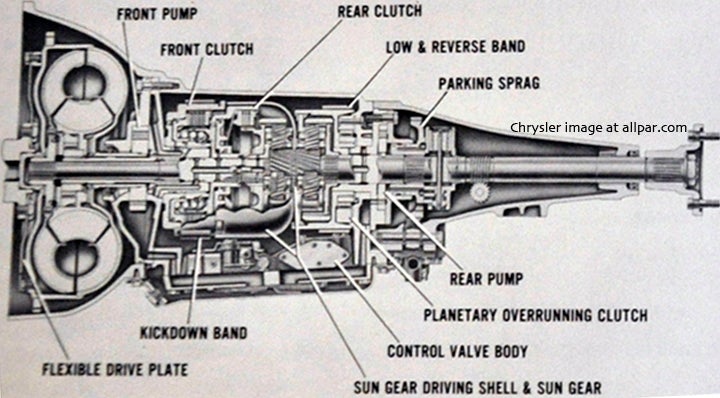
Valiant's all-new, three-speed automatic transmission was designed to obtain the performance flexibility of TorqueFlite from a lighter, more compact until tailored to the requirements for the car. Gear ratios are: 2.45:1 low, 1.45:1 kickdown, and 2.20:1 reverse. Functionally, the Valiant automatic resembles TorqueFlite. It has the same push-button operation, the same absence of neutral gear noise, the same smooth shifts, and the same excellent breakaway performance and efficient operation. In detail, however, it is an entirely new design.
The configuration of the gear box, for instance, was rearranged to eliminate the center support used in TorqueFlite and to allow the design of a one-piece converter housing and transmission case aluminum die-casting. Permanent mold aluminum planetary pinion carriers are used. All control system elements, with the exception of the governor valve, are combined in a single, one-piece valve body and transfer plate assembly. The compact, water-cooled, three-element torque converter is 10-3/4 inches in diameter, has a stall ratio of 2.25:1, and a stall speed of 1730 rpm when coupled to the Valiant engine. To minimize the axial space occupied by the converter, a flexible drive plate was introduced to permit the front pump to be driven directly on the impeller hub.
A parking sprag, actuated by a cable connected to an operating level below the transmission push buttons on the instrument panel, is used to lock the output shaft to the extension housing. The control lever mechanism incorporates over center action and is interlocked with the push-button box so that the neutral slide is automatically actuated when the parking sprag is engaged. Conversely, the parking sprag must be disengaged before forward or reverse positions can be selected.
In total, all internal components are tailored to the torque of the Valiant engine and are therefore smaller in size and lighter in weight. This new unit is 107 pounds lighter than the lightest TorqueFlite unit used with Chrysler Corporation V8 engines, and its compact design has allowed a low engine position and considerable reduction in the dimensions of the transmission tunnel. This may be seen in Figure 23. The TorqueFlite extension-mounted parking brake, has been replaced by Valiant's rear wheel parking brakes -- a factor which is partly responsible for the car's small transmission hump.
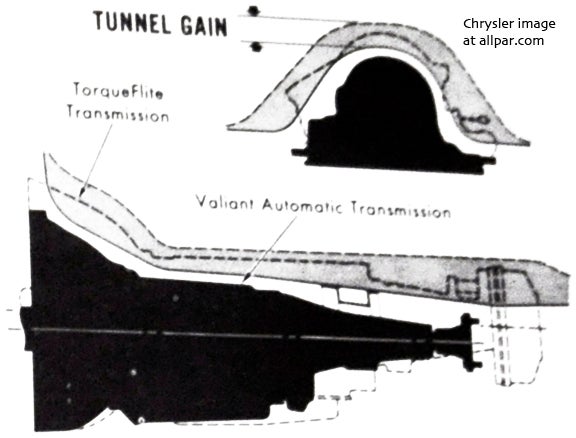
Rear Axle
Valiant's carrier-type hypoid rear axle, designed and built by Chrysler Corporation, differs from the banjo-type used of larger Corporation cars. The high 1-5/8 inch pinion offset is instrumental in lowering the propeller shaft and tunnel. Ring gear diameter is 7-1/4 inches. Two axle ratios are available for the domestic market, 3.55 being standard and 3.23 optional with both transmissions. A 3.91 ratio is available on export models.
Suspension
Torsion-Aire, a standard feature on all Chrysler Corporation cars since 1957, formed the design basis for the Valiant suspension system. It was agree during initial concept studies that the proven Torsion-Aire principles offered the ride and handling characteristics required to meet over-all Valiant design objectives. Torsion-Aire's rubber-bushed, torsion bar, ball joint, anti-brake-dip geometry front suspension and highly asymmetric Hotchkiss rear suspension frequencies with excellent car attitude control and car stability. It was known too, that Torsion-Aire's features and the low pressure 6.50 x 13 tires selected for Valiant would guarantee low harshness and road noise levels. Valiant's suspension components are, of course, smaller and lighter than those used on larger automobiles and incorporate certain unique features.
The front suspension lower control arms are carried on rubber-bushed pivot shafts and contain adjustable torsion bar front anchors. Location of the screw-type height adjuster mechanisms within the lower control arms affords a degree of corrosion protection and eliminates the need for a front floor pan formation over the torsion bar rear anchors. Lower control arm struts are bolted to the arms and rubber bushed at their forward ends. The complete lower arms are mounted to the K-shaped cross member which also carries engine front mounts and steering idler arm. The lower arms also carry the jounce bumpers and front shocks, the upper ends of which are received by the heavy-gauge shock towers described earlier.
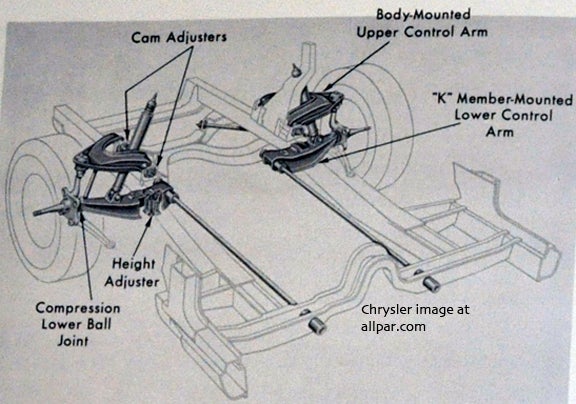
Upper control arms carry screw-in-type upper ball joints and are inclined at 14° to provide over 70% anti dip reaction at 05g braking deceleration. Upper control arm rubber bushings are positioned by cam plates incorporated in the attachments on the longitudinals, providing simple caster and camber adjustment.
Compression lower ball joints are screwed into the steering knuckle arms. This configuration allowed the lower joint to be positioned closer to wheel center line, thereby reducing scrub radius for improving braking stability and decreased steering effort. A bonus gained from this approach is the inherent fail-safe nature of the compression joint.
Valiant's rear suspension features sea-leg shocks and the highly asymmetrical leaf spring design associated with the Torsion-Aire system. The 55-inch springs are divided 20-35, with 20 inches forward of the axle, and play a major part in controlling body roll, acceleration squat, and brake dip. In addition, a most satisfactory propeller shaft tunnel to loaded rear seat relation is provided by a short axle pinion carrier, the pinion carrier mounted bumper, and the 1.25 degrees of axle control per inch of jounce travel developed by the springs.
As in the front, Valiant's rear suspension is mounted in rubber wherever it attaches to the body structure. One and three-eighths inch diameter bushings are used at the front eyes. The four-leaf spring incorporates a full-length interliner between the third and fourth leaves, and low-friction tip liners between all other leaves.
Suspension ride rates and roll rate distribution are as follows:
Wheel rate, front - lb/in. : 105
Wheel rate, rear - lb/in. : 125
Roll stiffness, front - lb/ft/deg : 232
Roll stiffness, rear - lb/ft/deg : 260
These characteristics, in conjunction with Oriflow-type shock control, Valiant's low center of gravity, and front and rear suspension geometries, give a flat, pitch-free basic ride and excellent cornering stability. Body roll is 3 degrees at 0.3g lateral acceleration. Relatively level acceleration and braking are indicated in the following tabulation of suspension deflections at the indicated rates of acceleration:
-10 ft/sec2, front: -0.35"
-10 ft/sec2, rear: + 0.45"
+10 ft/sec2, front: +1.15"
+10 ft/sec2, rear: -0.60"
Steering System
Symmetrical idler arm steering was selected for Valiant. Since ease of handling was a prime objective, a trailing pitman arm layout was chosen early in the program. Pitman arm, idler arm, and knuckle arms all swing through similar arcs, maintaining steering effort at an almost constant level from lock to lock. Small scrub radius, and the use of anti fraction bearings throughout the steering system results in a pleasingly low steering effort of 15 pounds at the rim of the steering wheel, through center, in dry parking. Maneuverability is excellent, with curb-to-curb turning circle of 37.1 feet.
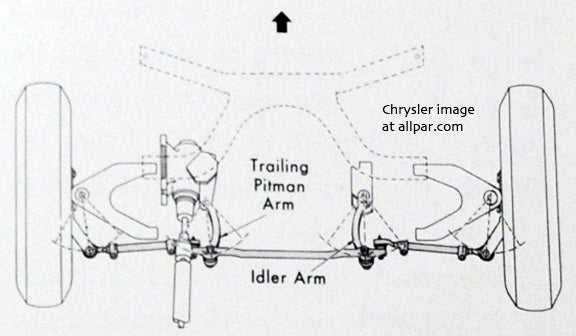
A recirculating-ball manual gear is used. The gear ratio of 20:1 and over-all ratio of 23.8:1 were selected to achieve an optimum balance between effort and response. Ball and needle bearings are used throughout the gear to achieve efficiencies up to 90%.
The manual steering system provides excellent handling characteristics with low steering effort.
A power steering system also is offered in recognition of the well-established consumer interest in power-assisted accessories. The power gear ratio of 15.7:1 and over-all ratio 18.7:1 provide outstanding response and steering ease.
Brakes
Valiant's nine-inch diameter brakes are of the duo-servo type. Widths are 2-1/2 inches front and 2 inches rear. Total lining area is 153.5 square inches. Braking is highly effective throughout the entire speed range, providing excellent stability, long life, and fade resistance. The master cylinder is located high on the fire wall for convenient servicing. The cable-actuated, rear wheel parking brakes are foot-operated and hand-released. Large wheel slots provide maximum air flow around the brake drums for efficient cooling.
Conclusion
One of the most intensive test programs ever undertaken at Chrysler Corporation, covering every aspect of performance and reliability, has shown that Valiant eminently fulfills all of the engineering objectives. From the start of its trials, the car has performed splendidly, demonstrating roadworthiness of high caliber.
Ride and handling have proven outstanding, with achievement of ride characteristics previously associated only with the larger American cars. Valiant's low frequency, stable, and well-controlled ride is unusual for a vehicle of this size.
As for performance, data accumulated over hundreds of thousands of miles prove that Valiant need apologize to no one in this respect. The high acceleration and cruising performance targets established in product concept studies have been successfully attained. This has been combined with highly acceptable fuel economy, and many miles of normal driving have shown fuel economy capabilities well within the target range.
Finally, the endurance characteristics exhibited by the car and its every component are excellent. Test cars have repeatedly met and exceeded all Chrysler Engineering Proving Grounds standard for rough road endurance cycling.
The rare opportunity of designing a completely new automobile was an unusually satisfying experience for the engineers and stylists who created Valiant. All major design goals were achieved. To stamp the project a complete success, it remains only for the Valiant to assume its destined place in the prime vehicle market.

 Your Privacy Choices
Your Privacy Choices